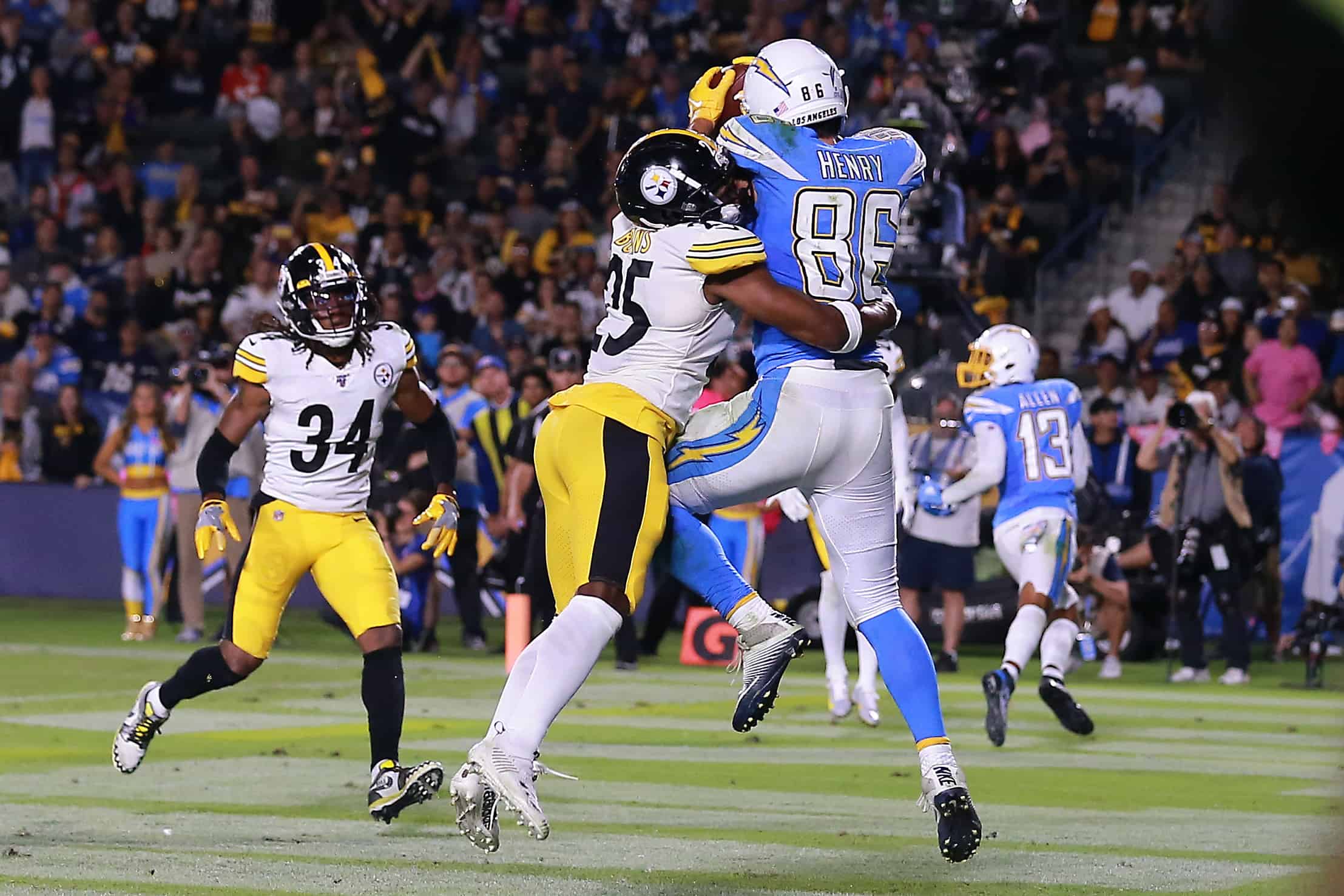It was an interesting week in the distribution of fantasy scores, with 17 different players and the Patriots DST putting up between 25 and 31 points, and only one player exceeding that.
Our top overall score comes in at 43.5 from Vikings WR, Stefon Diggs, with 7/167/3 on 11 targets plus 18 rushing yards. Last week, after complaints about the lack of usage in the Vikings offense, his teammate, Adam Thielen had a similar performance with 7/130/2 on eight targets. This week, it was Diggs as the squeaky wheel who got the grease, as he exceeded the field's next closest scores by 12.6 points.
Diggs had been a disappointment up to this point, accruing fewer than his 43.5 from Sunday in his first five games combined. He has shown upside before, with four previous games over 30, but this was his best to date. Diggs's struggles earlier in the season are not due to any fall-off in performance, but rather a different strategy from his offense.
The Vikings have made it no secret that they want to run the ball as much as possible, and have committed to that by reducing Cousins’s pass attempts per game from 37.9 in 2018 to 25.2 coming into this week, including only 10 pass attempts in Week 1.
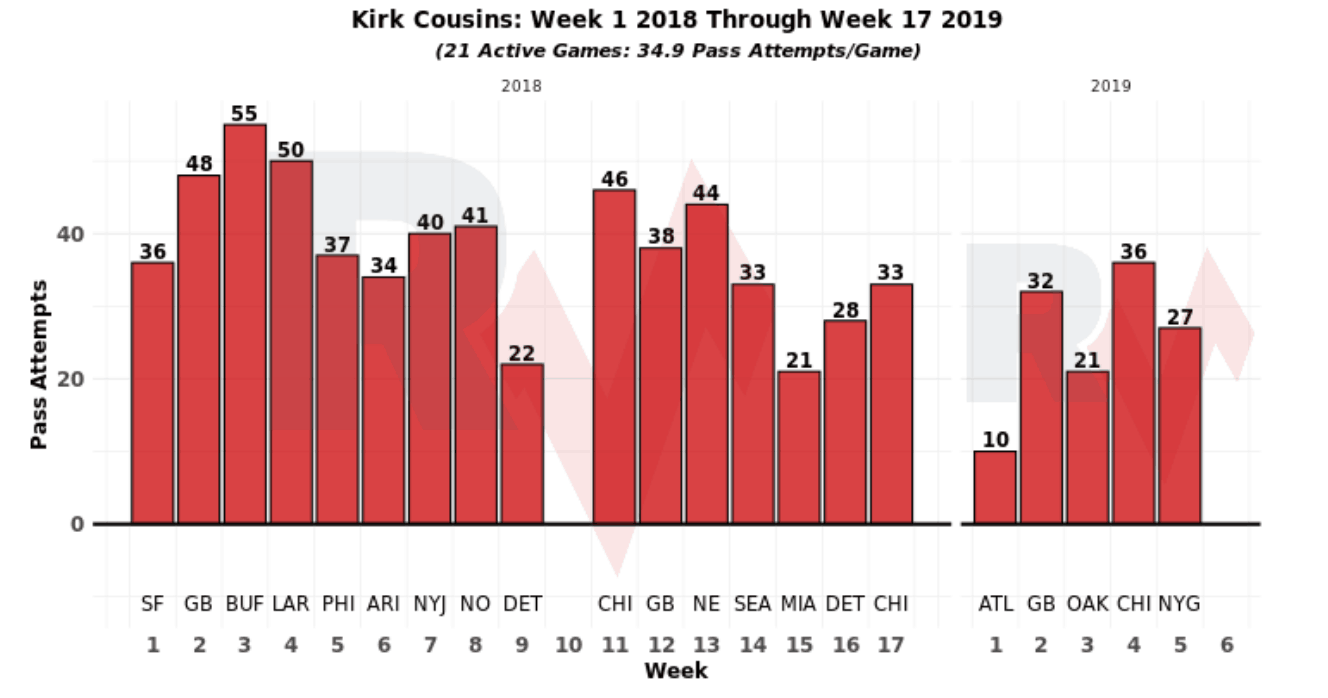
The Vikings were willing to throw against the Eagles, who were the sixth-toughest matchup for RBs and second-easiest for WRs per 4for4. If we can count on the Vikings to logically gameplan based on their opponents' strengths and weaknesses, there could be more spots for Diggs to produce this season. However, he does have another skilled WR in Thielen to compete for targets and it is also likely the Vikings slide back into their run-heavy strategy immediately. It will be tough to know when to trust Diggs in this iteration of the Vikings offense.

Tied for second with 30.9 points are Falcons QB Matt Ryan and Steelers RB James Conner. Ryan actually edged Conner out on NFL.com scoring with 30.94, but I won’t spend too much time on him other than to say he has been extremely consistent this year, throwing for over 300 yards every game and 3+ TDs in four of six. He’s a top-five QB in my eyes and should be started every week.
James Conner’s day could have been even better if not for the quad injury that sidelined him in the second half. He had 16/41/1 on the ground and 7/78/1 through the air. His rushing results were not impressive, but he is a great example of how valuable a heavy workload with pass-game usage can be for a fantasy RB. He has not rushed for over 55 yards yet this year, nor earned better than 4.2 YPC in any game (3.3 average). In spite of that, this is the second time he has gone over 25 fantasy points because of his receiving production.
His targets had been consistent until Week 5, where he had none against the Ravens and the Steelers have utilized more of a backfield by committee approach than in previous seasons. His percentage of offensive snaps played is down to 62% this season from 81% when he was healthy last year. It was trending back upwards with RB2 Jaylen Samuels out with an injury, but now with an injury of his own, I wouldn’t count on that to continue.
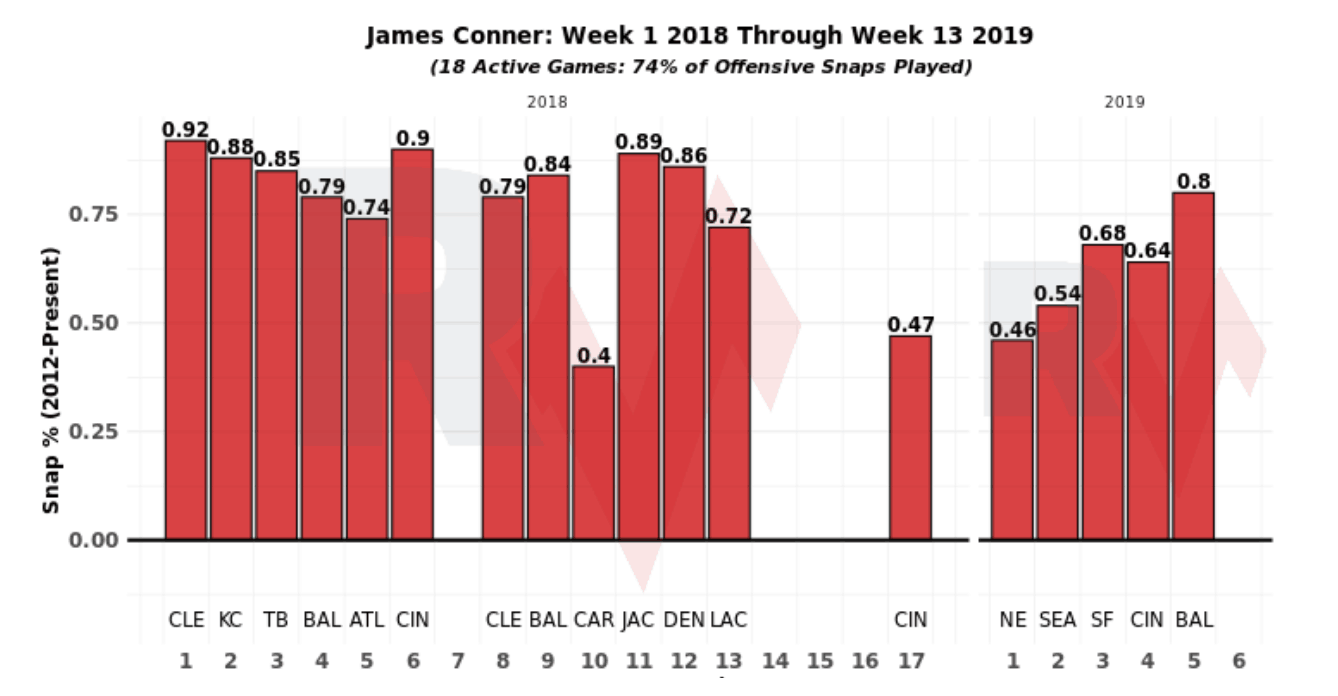

Fourth this week is Ravens QB Lamar Jackson with 30.6 points. He gained an absurd 152 rush yards and his lone TD strictly with his legs, good for 21.2 points and over double his average rushing expected fantasy points per game.
He was facing the lowly Bengals, who rank 31st against RBs per 4for4. Jackson is the one QB in the league who gets true RB-type usage regularly, and this was an ideal scenario. It is a relief to see coach John Harbaugh, has no reservations about giving Jackson a high number of carries in the matchups where it makes sense.
Jackson has only dropped below 20 points in one game this year and is the fourth-ranked QB overall, within five points of the top spot. Rushing QBs are the Konami Code (h/t Rich Hribar) of fantasy football, and Jackson is the most extreme version the NFL has ever seen.
In his 12 starts before this one, Jackson had averaged 9.1 RuEFP per game, more valuable than two passing TDs or 200 yards. He was missing his WR1, Marquise Brown, due to injury in this game, but still managed to throw for 236 yards with no TDs or INTs. Jackson is another top 5 QB who I would start regardless of matchup.
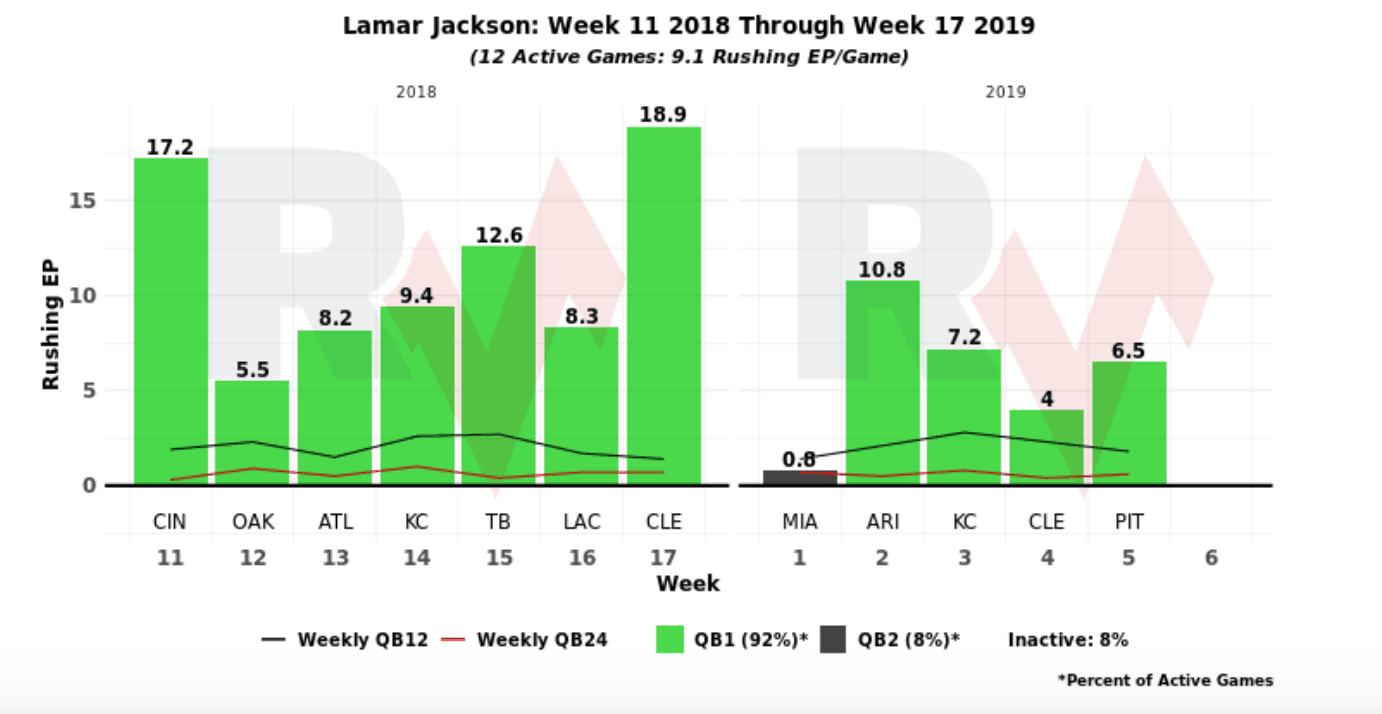

Ending the top five, and the player I’m most excited about is Chargers TE Hunter Henry with an even 30 points. He got there with 8/100/2 on nine targets. I’m quite impressed, given that no projections had Henry higher than 10 points, and this was his first game back from his Week 1 injury.
A fully-healthy Hunter Henry is something I’ve always looked forward to every time he goes down. With this 30 point result included, he’s now averaged 10.4 PPG in his young career, good for 19th all-time. In his 28 games before this one, he had only underachieved in fantasy points (based on his opportunity) six times, averaging 2.1 fantasy points over expectation. This metric shows that he is more efficient than average on a consistent basis.
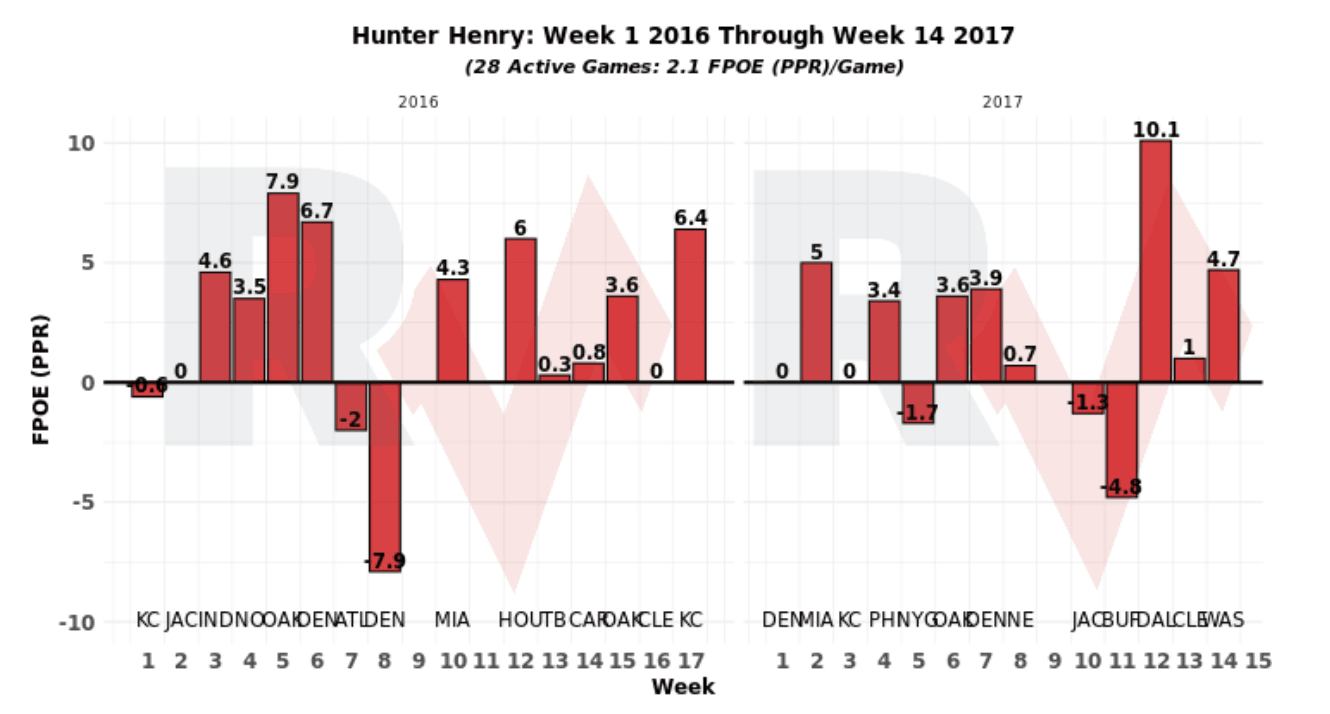
The Chargers’ other big-bodied red zone target, Mike Williams, left this game with yet another injury, which may have contributed to Philip Rivers looking Henry’s way on his two TDs, though he was wide open on both. If Williams is limited or inactive, Henry’s target share will get a boost and he will likely get extra red zone opportunities. He is a borderline top-5 TE at an ugly and unreliable position.


